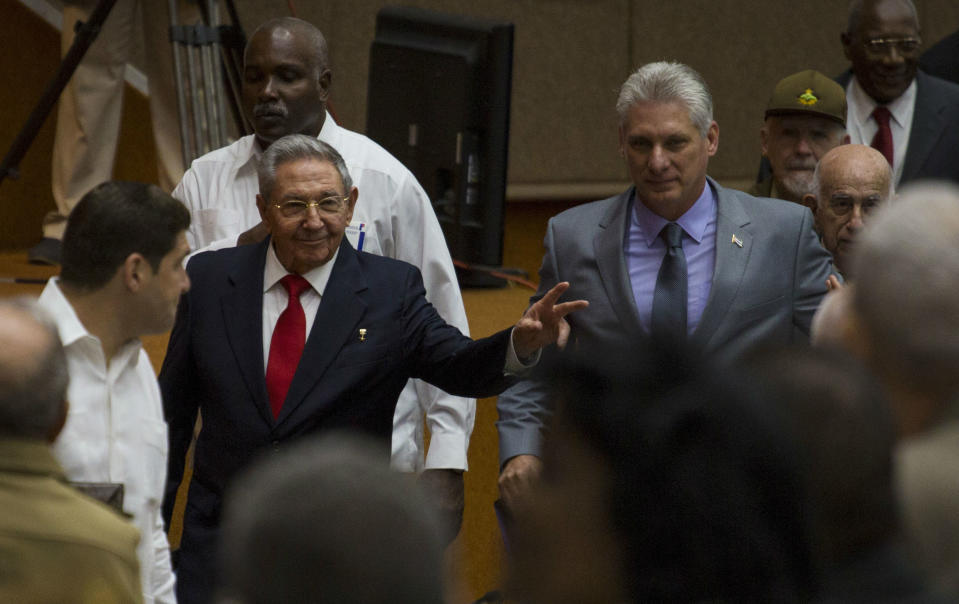Miguel Diaz-Canel elected as president of Cuba
Cuba has confirmed that Miguel Diaz-Canel, a Communist Party loyalist, is to replace Raul Castro as president – bringing an end to the 59-year era of rule under the Castro brothers, though almost certainly not their influence or power.
Politicians in the country’s National Assembly announced the vice president had been selected to replace the brother of Fidel Castro, who had taken charge of the country after his brother fell ill in 2011. Fidel Castro, the driving force behind the country’s revolution and who ruled it it with a fist that was frequently cast of iron, died in 2016.
Reports said there was little surprise about the ascension of Mr Diaz-Canel, of which little is said to be known by the international community; he was the sole candidate in the assembly secret ballot and therefore all but guaranteed of victory in Cuba’s single-party system.
Miguel Diaz-Canel has been elected as Cuba’s new president#SomosContinuidad #Cuba #PorCuba pic.twitter.com/eDXaaLjXVI
— Granma (English) (@Granma_English) April 19, 2018
In his first televised address to the nation, Mr Diaz-Canel vowed to continue the socialist revolution that was established by the Castros. He said that Cuban foreign policy would not change and he would not negotiate the nation’s principles.
At the same time, he said Cuba was always ready to to engage in dialogue with those who “treat us as equals”.
The replacing of the 86-year-old Mr Castro by the 57-year-old vice president, marks an obvious generational shift and underscores that many in the country – 70 per cent of people are aged below 54 – have no first hand experience of the early, dramatic days of the revolution, that made the Castros heroes to many around the world, yet which would set them against the US for decades.
Rather, many have grown up knowing years of both plenty and shortage. For years, the island was supported financially and strategically by the Soviet Union. But after the Soviet Union collapsed in 1991, the subsidies that had helped maintain life in Cuba dried up; daily calorie intake fell from 2,908 calories per day in the 1980s to a reported 1,863 calories per day in 1993.
This moment was when many in the US believed Castro’s regime would collapse. As it was, the country re-engineered its agriculture system, being forced to adopt an almost organic approach across the island in the absence of imported fertilisers.
In more recent years, Cuba developed an important relationship with the late Venezuelan leader Hugo Chavez, a man who idolised Fidel Castro and sought to spread their ideology across the region. In exchange for Cuban doctors who were dispatched to work in Venezuelan clinics, Chavez dispatched oil.
As the Venezuelan economy has imploded following Chavez’s death and the era of incompetence and apparent corruption that has played out under his successor Nicolas Maduro, Cuba has looked to develop tourism, allow some private business and loosen some of the state-imposed economic regulations that marked many of the Castro years.
The changes presaged a remarkable announcement at the end of 2014 when Raul Castro and Barack Obama revealed they had been secretly negotiating to end the diplomatic standoff that has existed for 54 years, during which time Washington had tried to assassinate Fidel Castro on countless occasions.
The rapprochement saw a lifting of US sanctions that had been aggressively enforced for decades, and the opening of embassies in the countries’ respective capitals. That re-engagement has somewhat faltered since the election of Donald Trump, who rolled back some of the Obama administration’s changes.
Mr Castro will remain head of the Communist Party, which is designated by the constitution as “the superior guiding force of society and the state”. As a result, he may still be the most powerful person in Cuba for the time being.
“I like sticking with the ideas of President Fidel Castro because he did a lot for the people of Cuba, but we need rejuvenation, above all in the economy,” Melissa Mederos, a 21-year-old schoolteacher, told AP. “Diaz-Canel needs to work hard on the economy, because people need to live a little better.”

 Yahoo News
Yahoo News 

